

When Coal Comes to Paradise. LAMU, Kenya—China’s ambition to become a world leader on climate change has led its government to pursue an ambitious initiative to reduce emissions domestically.

Amid massive reforms to switch to cleaner energy sources such as natural gas, China has barred new coal plants in 10 regions and proposed suspending construction of more than 100 coal plants last year. China’s carbon-dioxide emissions grew by 2.3 percent in 2018, and are set to peak in 2030. (There has been some easing of restrictions, Bloomberg reports, indicating how coal-dependent China remains.) Still, the growth is slower than climate researchers expected. With investments in alternative energy increasing and domestic demand for coal-fired power dropping so quickly, China has been left with a surplus of labor, technology, and equipment. While China is on track to meeting its Paris climate agreement targets domestically, it continues to invest in and profit from coal power projects across the world. Debt Trap? Drought 'shuts down Amazon carbon sink' Escape from the Amazon. Alarm as study reveals world’s tropical forests are huge carbon emission source.
The world’s tropical forests are so degraded they have become a source rather than a sink of carbon emissions, according to a new study that highlights the urgent need to protect and restore the Amazon and similar regions.
Won’t these people be prosecuted for allowing this to continue? – eveplant1
Hasn’t this been closely monitored over time, if so, why haven’t they realised what’s been happening and made more of an effort to stop it before it’s too late like it is now – eveplant1
So if they stop deforestation will it still be a carbon source or will we need to afforest the area to make it stable again? – eveplant1
Researchers found that forest areas in South America, Africa and Asia – which have until recently played a key role in absorbing greenhouse gases – are now releasing 425 teragrams of carbon annually, which is more than all the traffic in the United States.
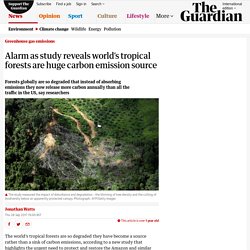
This is a far greater loss than previously thought and carries extra force because the data emerges from the most detailed examination of the topic ever undertaken. The authors say their findings – published in the journal Science on Thursday – should galvanise policymakers to take remedial action. “This shows that we can’t just sit back. This can reduce biomass by up to 75%. To get more accurate data, scientists combined 12 years of satellite data with field studies. . … we have a small favour to ask. From carbon sink to source: Brazil puts Amazon, Paris goals at risk. Brazil is committed to cutting carbon emissions by 37 percent from 2005 levels by 2025, to ending illegal deforestation, and restoring 120,000 square kilometers of forest by 2030.
Prosecution has been happening, but it's slow and patchy. And in some instances there simply hasn't been any interest in prosecution, and some government officials have been caught up in cases of corruption covering for those who have caused the deforestation. I've written a little more about these issues here: – drwhittall
What actions are they taking to prosecute those who are illegally logging? – eveplant1
Scientists warn these Paris commitments are at risk due to a flood of anti-environmental and anti-indigenous measures forwarded by President Michel Temer.
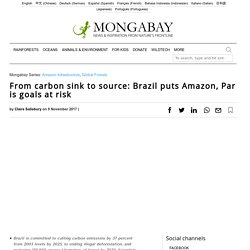
Post-drought decline of the Amazon carbon sink. Remote sensing data Our study region covers the entire Amazon forests within the boundary of north and central South America (19°S–12°N; 81°W–44°W).
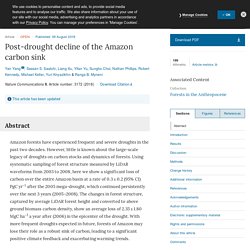
We used pixels identified as Evergreen Broadleaf Forests (EBF) in the latest Moderate Resolution Imaging Spectroradiometer (MODIS) Land Cover (LC) product41. The EBF pixels were defined from the year-2005 LC map for our observational period (2003–2008) to ensure capturing the forest changes triggered by the 2005 Amazon drought. The MODIS Vegetation Continuous Field (VCF) product42 was also used to further stratify the pixels. By taking the maximum VCF values from 2003 to 2008 as VCFmax, our study region would only focus on the dense tropical forests (VCFmax > 60%). Increasing Frequency of Drought Is Changing the Amazon From Carbon Sink to Source - Pacific Standard. Because they take vast amounts of carbon dioxide out of the atmosphere, rainforests are an important part of the planet's carbon cycle and their conservation is playing front and center in major international efforts to combat global warming.
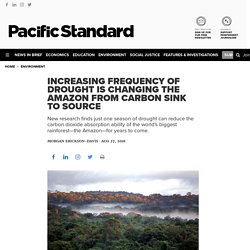
But new research finds just one season of drought can reduce the carbon dioxide absorption ability of the world's biggest rainforest—the Amazon—for years to come. And as droughts seem to be occurring more frequently in rainforests, scientists worry that these important carbon sinks may instead become carbon sources. In a study published recently in Nature, scientists at NASA's Jet Propulsion Laboratory used lidar data captured by satellites to map changes in forest canopy in the Amazon following a particularly severe drought in 2005.
Lidar, which stands for "Light Detection and Ranging" uses lasers to measure distances and create three-dimensional representations of surface features like canyons, craters, and, in this case, trees. 03 06.4. UN Says Climate Genocide Coming. But It’s Worse Than That. You now have permission to freak out.
Exactly right Eve - there are real signs that the scientific evidence has been known for many years, but politicians have refused to take sufficient action. There's a strong chance that the recent Brazilian elections could see things get even worse, given what Brazil's new right wing President Jair Bolsanaro has had to say on climate change and the rainforest. For example, take a look at this: – drwhittall
It annoys me that these IPCC talks have so much emphasis when countries that have agreed to it don’t or can’t control it or drop out of the agreement. The agreement itself is so so important but some countries involved don’t seem to see the severity of what they’re doing like Donald Trump who until recently claimed that climate change and global warming were all fake news! – eveplant1
Photo: George Rose/Getty Images Just two years ago, amid global fanfare, the Paris climate accords were signed — initiating what seemed, for a brief moment, like the beginning of a planet-saving movement.

But almost immediately, the international goal it established of limiting global warming to two degrees Celsius began to seem, to many of the world’s most vulnerable, dramatically inadequate; the Marshall Islands’ representative gave it a blunter name, calling two degrees of warming “genocide.” Carbon systems - feedback loops. METEO 469: From Meteorology to Mitigation: Understanding Global Warming D7. As we saw earlier in the course, the airborne fraction of CO2 in the atmosphere has increased by only half as much as it should have given the emissions we have added through fossil fuel burning and deforestation.
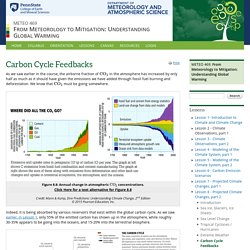
We know that CO2 must be going somewhere. Figure 8.8: Annual change in atmospheric CO2 concentrations. Click Here for a text alternative for Figure 8.8. 'Tipping points' could exacerbate climate crisis, scientists fear. Key dangers largely left out of the IPCC special report on 1.5C of warming are raising alarm among some scientists who fear we may have underestimated the impacts of humans on the Earth’s climate.
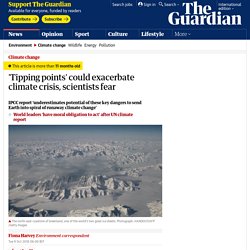
The IPCC report sets out the world’s current knowledge of the impacts of 1.5C of warming and clearly shows the dangers of breaching such a limit. However, many scientists are increasingly worried about factors about which we know much less. These “known unknowns” of climate change are tipping points, or feedback mechanisms within the climate system – thresholds that, if passed, could send the Earth into a spiral of runaway climate change. 6A: Down to the Deep - The Ocean's Biological Pump. Part A: Down to the Deep - The Ocean's Biological Pump Oceans have a large capacity to absorb CO2, thus reducing the amount of CO2in the atmosphere and bringing carbon atoms into the ocean system.

Many CO2 molecules that diffuse into sea surface waters diffuse back to the atmosphere on very short time scales. However, some of the carbon atoms from these original CO2 molecules stay in the ocean for time scales of hundreds to thousands of years. If some carbon atoms eventually make it to the bottom of the ocean sediment, they can be stored for time scales of millions of years. The Ocean Carbon Cycle. Geoengineering may be used to combat global warming, experts say. The world may increasingly look to geoengineering in the wake of the latest UN climate report, which says it could be adopted as a temporary “remedial measure” if the world heads towards dangerous levels of warming.

The authors of the new 1.5C study by the Intergovernmental Panel on Climate Change say there is high agreement that the injection of millions of tonnes of sulphur dioxide into the stratosphere could help limit temperature rises to the most ambitious target of the Paris accord. But the authors warn there are major uncertainties about the social, environmental and ecological impacts, which mean the world would be far better off if policymakers strengthened natural cooling systems such as forest cover and accelerated efforts to reduce carbon emissions. The Geological Carbon Cycle. The origin atmosphere of the Earth was rich in reduced gases including methane, CH4. The carbon content of the Earth steadily increased over eons as a result of collisions with carbon-rich meteors. As the oxygen content of the atmosphere increase, the carbon-containing molecules were oxidized to CO2. Carbon dioxide, an acidic oxide, and carbonic acid have slowly but continuously combined with calcium and magnesium oxides, basic oxides, in the crust to form insoluble carbonates.
Carbon dioxide in water, or carbonic acid, also reacts with silicate rock. The chemical weather of calcium silicates by carbonic acid produces calcium carbonate and silicon dioxide. The Carbon Cycle. This page contains archived content and is no longer being updated. At the time of publication, it represented the best available science. However, more recent observations and studies may have rendered some content obsolete. Through a series of chemical reactions and tectonic activity, carbon takes between 100-200 million years to move between rocks, soil, ocean, and atmosphere in the slow carbon cycle. Understanding the long-term carbon-cycle: weathering of rocks - a vitally important carbon-sink. Posted on 2 July 2013 by John Mason above: the processes of the long-term carbon-cycle that this post explores.
Graphic: jg. This post delves into the long-term carbon cycle that involves the interactions of the atmosphere with rocks and oceans over many millions of years. Because of its length, I've broken it up into bookmarked sections for easy reference: to come back here click on 'back to contents' in each instance. Contents Introduction: what is weathering? The Carbon Cycle & Carbon Stores.
This is the worst Geography joke I have ever heard. – mrfreergeog
Very helpful video, will watch multiple times through out my geog career. Didn’t like their voice however – elliot_mohan
Climate urgency: we've locked in more global warming than people realize. While most people accept the reality of human-caused global warming, we tend not to view it as an urgent issue or high priority.
Like for example in the cryosphere? When the temperature drops more ice forms as water freezes. Solar radiation is then reflected from the ice. However, when it is warmer, less ice forms because it can't freeze and therefore less solar radiation is reflected and it will gradually heat so it's therefore a negative feedback system as there is less ice as there initially was. Solar radiation doesn't leave so the earth gradually heats. Just a guess, like. – oliviaendeavour
I love a one way conversation. – mrfreergeog
'So far humans have caused about 1°C warming of global surface temperatures' - its interesting how much difference that 1°C can do. – oliviaendeavour
That lack of immediate concern may in part stem from a lack of understanding that today’s pollution will heat the planet for centuries to come, as explained in this Denial101x lecture: So far humans have caused about 1°C warming of global surface temperatures, but if we were to freeze the level of atmospheric carbon dioxide at today’s levels, the planet would continue warming. Over the coming decades, we’d see about another 0.5°C warming, largely due to what’s called the “thermal inertia” of the oceans (think of the long amount of time it takes to boil a kettle of water). The Earth’s surface would keep warming about another 1.5°C over the ensuing centuries as ice continued to melt, decreasing the planet’s reflectivity.
Rise in atmospheric CO2 slowed by green vegetation. Image copyright SPL The growth in the amount of CO2 in the Earth's atmosphere has been slowed by the increased ability of plants to soak up the gas. A new study says that green vegetation has helped offset a large fraction of human related carbon emissions between 2002 and 2014. Plants and trees have become more absorbent say the authors, because of so much extra CO2 in the atmosphere. Expansion of agricultural land reduces CO2 absorption.
Or the real question is will this actually stop? Right now we are exponentially using more non-renewable resources like fossil fuels. The demand for forestry and food industry once again not going to suddenly halt because of our ever growing population. It is not till somebody innovative comes up with renewable options which are just socio-economically beneficial but their environmental and ecological impact are much lower or "carbon neutral." Until then, we are going to continue till we hit a brick wall, where fossil resources are scarce, the rainforest landscapes looks like Lancashire! Until that point we will only be taking action but it will be too late! – townsendlsamuel
Look back at the diagram we were using yesterday Thomas - there should be some clues in there. But the more direct question might be not which of the two is the biggest cause of CO2 emissions, but rather which one is easier to mitigate against through changes to our lifestyles, societies and economies? – drwhittall
Congo basin’s peaty swamps are new front in climate change battle. MrC’s Tree carbon content calculator. Where do trees get their mass from? When Permafrost Melts, What Happens to All That Stored Carbon?
Great discussion chaps, top stuff! – drwhittall
Climate and the Carbon Cycle: Unit Overview. Climate's magic rabbit: Pulling CO2 out of thin air. GCP : Global Carbon Project : Homepage. First CO2 rise in four years puts pressure on Paris targets. Image copyright Getty Images.
Possibly we have now past the point of no return. Possibly from now on no matter how we influence carbon emissions positive feedbacks will take over! – townsendlsamuel
Record surge in atmospheric CO2 seen in 2016. Image copyright Getty Images. A brief history of the Earth's CO2. Image copyright Getty Images. Record surge in atmospheric CO2 seen in 2016. Explainer: what dust from the Sahara does to you and the planet. Plastic bottle deposit return scheme could save England's councils £35m a year. Sewage plants are leaking millions of tiny plastic beads into Britain's seas. Oxford aims to cut air pollution with car ban in zero emissions zone.
Yep, this is an important argument. No-one yet knows the full implications of the shift to electric vehicles for transportation. Ethan Clarke in year 13 is doing his EPQ about exactly this question - it'd be worth talking with him about this. – drwhittall
They talk in this article about electric taxis, will these be cheeper or more expensive than current petrol taxis because I thought that apart from maintenance the taxi price was for petrol/ diesel. – eveplant1
Fossil fuels win billions in public money after Paris climate deal, angry campaigners claim. European countries spend billions a year on fossil fuel subsidies, survey shows. Climate change reducing ocean’s carbon dioxide uptake. Scientists study ocean absorption of human carbon pollution. Giant icebergs play 'major role' in ocean carbon cycle. The Ocean's Carbon Balance : Feature Articles. The carbon cycle in the Earth System. What is the carbon cycle?
The Conversation Carbon Cycle Articles. ESRL Integrating Research and Technology Theme: Carbon Cycle Science. Carbon stores and cycles. Just 100 companies responsible for 71% of global emissions, study says. Study: our Paris carbon budget may be 40% smaller than thought. Ultimate bogs: how saving peatlands could help save the planet.
Countries with coral reefs must do more on climate change – Unesco. Planet has just 5% chance of reaching Paris climate goal, study says. How to offset Trump's climate science ignorance – plant 10bn trees. Exxon, Stephen Hawking, greens, and Reagan’s advisors agree on a carbon tax. Methane emissions from cattle are 11% higher than estimated. Global carbon emissions stood still in 2016, offering climate hope. Queensland tree clearing wipes out federal emissions gains. Carbon emissions from warming soils could trigger disastrous feedback loop. The Carbon Cycle : Feature Articles. Australian health groups urge coal phase-out and strong emissions reduction.
Geological processes in the carbon cycle. Small Streams Make Big Contribution to Carbon Cycle. Scientists probe underground depths of Earth’s carbon cycle. Forest loss means tropics emit more carbon than they trap. Overview of the Carbon Cycle from a Systems Perspective. Giant icebergs play 'major role' in ocean carbon cycle.